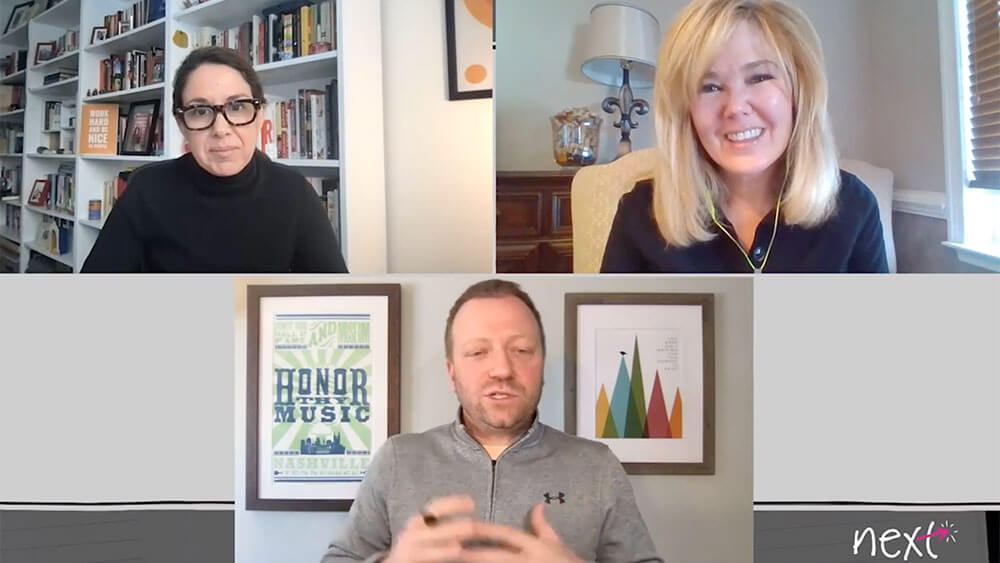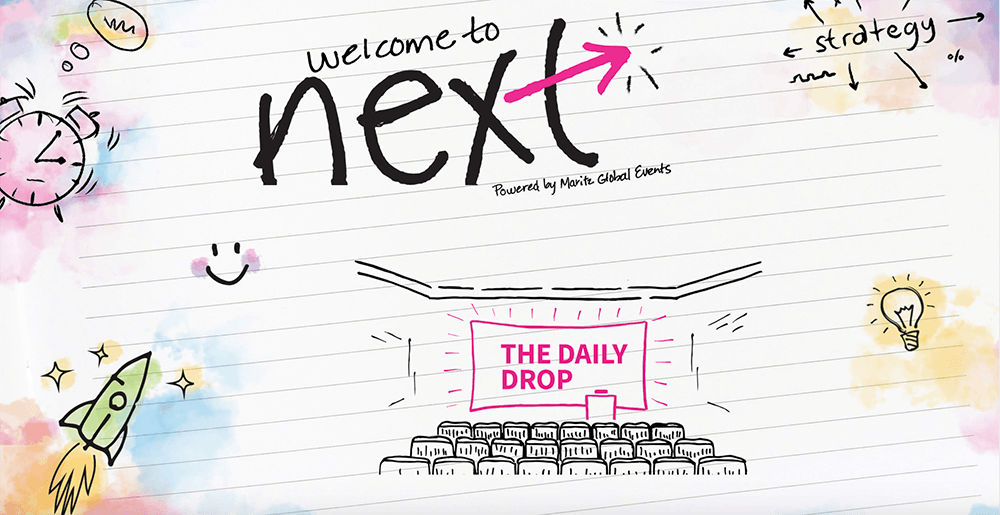
Alex Sapiz, vice president for global events for Cisco (clockwise from top left); Lauren Parr, vice president for meetings at the American Geographical Union; and Timothy Simpson, brand and engagement chief strategist for the Design Studio, talk about disruption during a NEXT Conference session.
No one would downplay the negative impact COVID-19 has had on the events industry, the world, our families, and communities, said Timothy Simpson, brand and engagement chief strategist for the Design Studio, by Maritz Global Events. But historically, there has been a brighter side to massive disruption, Simpson pointed out during a session at Maritz’s NEXT conference, a one-session-per-day live and on-demand program, spread out over three weeks in February. Periods of disruption have been followed by periods of rapid growth, Simpson said, in part as a result of how disruption “leads to new ideas and new ways of seeing the world and thinking.”
At NEXT on Feb. 9, Simpson talked about the definition of disruption and lessons learned over the last year with two industry executives who oversee large global meeting programs. For Alex Sapiz, vice president for global events for Cisco, the disruption brought about by the pandemic “has been about innovation, honestly,” Sapiz said. “We’ve had to transform everything that we knew — we had to transform the way we worked, we had to transform the way we executed events, and the final product. It’s been all about innovation and learning new ways of doing things.” At the American Geographical Union (AGU), where Lauren Parr is vice president for meetings, scientists view disruption as an accelerator, Parr said. “They understand that, like it or not, you can’t get comfortable. We’re oriented towards [disruption] — but it doesn’t make it any less difficult.”
Among other things, Simpson asked Parr and Sapiz to talk about what they would leave behind and what they would be taking forward with them, based on their experiences over the last year.
What Will You Leave Behind?
Sapiz: The idea that digital events are less expensive, easier to produce, and take less time than in-person events. “Nothing could be further from that statement,” Sapiz said, although many began 2020 with that perception. “That concept never had any legs for me and my team, but we had to bring leadership on board to understand it,” she added. “We know you can spend a pretty decent amount of money on a digital experience, if you want to create the right experience.”
The other thing Sapiz would leave behind is the idea that every digital event must be bespoke — designed for that event only. Instead, she envisions the development of a foundation “for multiple digital experiences, where you are reusing a platform, without recreating it time and time again.”
Parr: “The idea of an engagement arc,” she said, “where we all get together for a brief moment in time and then we all go back to our normal lives and the engagement ends.” Parr would also leave behind the orientation of virtual events as being a separate thing, she said. “We clearly established the value of in-person engagement at events, but we’ve also clearly established the value of virtual engagement. We used to view virtual engagement as access — you turn it on. It is much, much richer than that, and we all know that.”

Maritz’s NEXT conference is a one-session-per-day live and on-demand program that is spread out over three weeks in February.
What Will You Take Forward?
Parr: “We just came away from one of the most diverse and inclusive meetings we have ever been able to have — that’s part of our strategic plan and we are trying to make measurable gains in that space,” she said. The virtual meeting gave AGU “the opportunity to talk to those different communities that we are seeking to bring in in a way that doesn’t bind them to travel and heavy expenses to come to a meeting that they are unfamiliar with,” she said.
“We didn’t look at it like virtual would potentially cannibalize us down the road — we looked at virtual as a gateway to creating the meeting that we want to create going forward,” Parr added. “We hope we can leverage this new reality to include people who’ve never been able to come [to the annual meeting] before.” The AGU’s intention, Parr said, is to co-create the virtual experience with potential attendees, “so that it’s not just an add-on experience,” but one that is authentic, inviting, and that attendees feel like they have some ownership of.
Sapiz: “Design for digital” is a very strong north star, Sapiz said. Her team will never try to simply translate iconic elements of an in-person experience into a digital version, she said. “We start with strategy and scratch everything we knew. And we continue to talk to the audience and listen to them — you know them and you know the elements of the experience that are important to them.
“In so many ways, we are producing television” with a digital event, she said. “You have to seek to understand what your audience wants and cares about from these new experiences, and seek continued improvement,” she said. “What worked last time may not at your next event. Rapid prototyping and continued innovation are critical for us.
“I can’t tell you what the next iteration of events is going to be six, nine, or 12 months from now,” Sapiz said. “What I can tell you is that the digital event will remain a constant. I think we will be deploying that platform for things other than these ‘moments in time’ that support a big flagship event — as a way of continuing the journey.”
Barbara Palmer is deputy editor of Convene.
